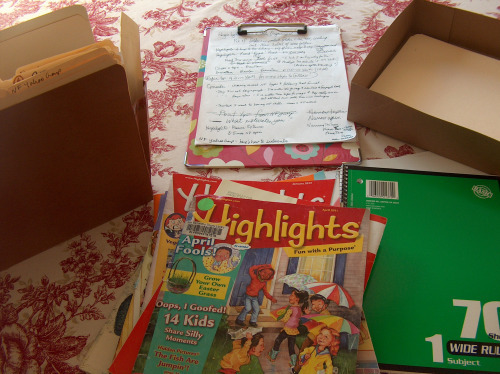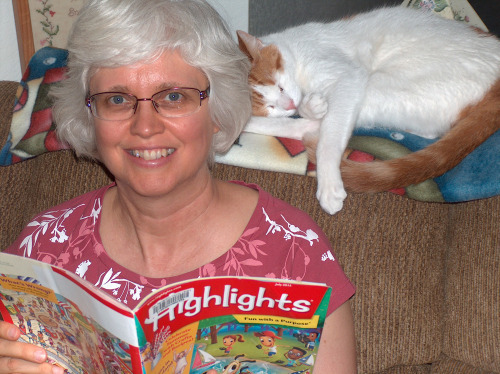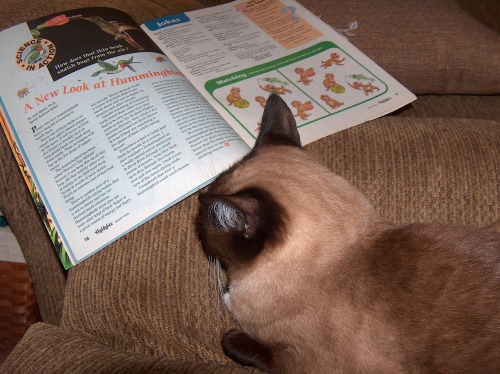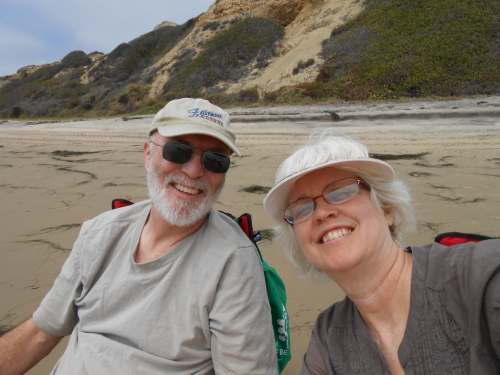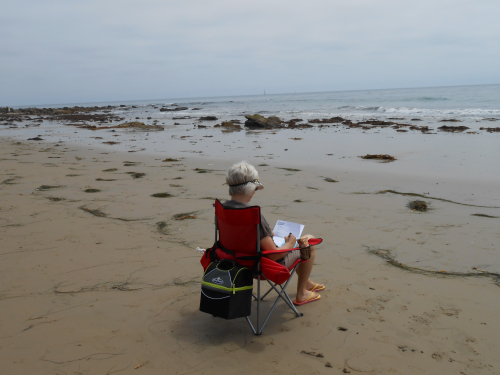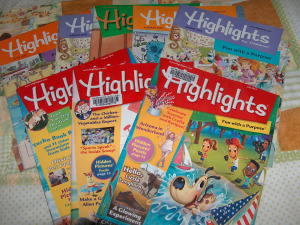Nancy I. Sanders's Blog, page 72
August 29, 2013
Highlights: Let’s Get Organized
By now, I’ve been busy getting organized. I’ve learned from past experience that getting organized helps in so many ways. It makes info easy to find at my fingertips. It keeps all my notes on a current project in one place. It also helps my thoughts get more focused as I divide up the journey into bite-sized chunks.
STEP EIGHT
So let’s get organized! If you have your own organization system, put it to work. If you don’t, I highly recommend using expandable pocket folders. I started using this system after I visited my Scholastic editor at the publishing house in New York City. She used this system and I thought…hey! If it works for an editor in a top publishing house, it’s gonna work for me!
As you can see in the photo, I have a bunch of file folders in my expandable pocket folder on the left. I dug around and found file folders I’d gathered in previous years when I’d researched more about Highlights magazines, so I put them in my pocket folder, too, just in case I might discover a nugget to use now.
I also got my box of manila file folders and created some files for this current project. Here are some of the folders I created and why:
Current Needs: In here I keep the info I printed out with their list of current needs. That way I can always find it quickly.
NF Yahoo Group: In here I keep the tips people post in the nonfiction listserv about their success stories working with Highlights.
Nonfiction ideas: This is the file folder I tuck in all my ideas, big and small. Ideas are like gold, so I treasure each one and try not to let it slip away from me. Not only will this be a great resource as I’m working to narrow my topic, but it will also provide ideas for future potential articles.
Sample NF Articles: This is the file folder where I collect samples of published stories and articles from Highlights that are similar in format to the one I want to write. Since my local libraries have given me permission to Xerox anything I get on loan from them for personal research, I tuck photocopied stories as well as stories I type out word for word. (More about this in an upcoming post.)
Manuscript: I also have a file folder for the manuscript I’ll be writing. It’s empty now but as I start to work on it in chunks, I’ll plan to print out various versions and store them in here. I like to have paper copies in case my computer crashes etc.
Research: In this file, I’ll store any research notes I print out or keep as I work on my article.
Bibliography: I’ll keep a bibliography in here printed out of books, articles, and Internet sources I use on this project.
Photographs: This is where I’ll store notes or e-mails or information about potential photographs to recommend be used with my article.
Endorsements: This is where I’ll store notes or e-mails or information about the expert(s) I contact to endorse my article.
Submission: This will hold a copy of my final submission so I can always access it in one handy place.
Highlights: Last, but not least, this is a file folder I created to hold any e-mails or correspondence I have with the editors at Highlights.
Why do I have so many folders you might ask when most of this information is on my computer? Let’s just say that my computer has crashed far too many times or files gotten corrupted or lost for me to feel comfortable keeping everything on the computer.
I like to print out paper copies of stuff as much as possible.
And here is where I’ll keep it all organized in one handy spot. Plus, there’s plenty of room to tuck in my green notebook at night that I’m carrying around with me everywhere right now to jot down ideas or thoughts that pop into my head. And a clipboard where I clip my main focus at this point. And samples of my magazines.


August 28, 2013
Highlights: Brainstorming Ideas
There are no right or wrong steps to take as you’re working to write a nonfiction article to submit to Highlights.
It’s okay to do whatever works for you to experience success.
The steps I’m sharing with you are steps that I’m taking…actually taking…along my own journey to do this. And here’s the nitty gritty on the next step I’ve been taking. This is the information I promised to you in an earlier post where I said I’d share what my brain has been doing to pick a topic to write about.
STEP SEVEN
Brainstorm ideas to help narrow the topic down to the one main topic you want to write about. Studying the target publisher has really helped me along the way. That’s why I shared the previous posts before I shared this one.
Here are some of the thoughts and questions I asked myself as I brainstormed ideas to narrow the topic:
* Do I want to write about something I know nothing about that will require hours of research from square one and multiple trips to the library and a brand new playing field all around? (The benefits of doing this are many in that it’s lots of fun to start fresh plus it will expand my capabilities as a writer.)
* Or do I want to write about something I’ve already researched and written about before?
(Just for your info, in the end I decided to write about a topic I’ve written about in one of my books, so I have to be careful not to overstep my boundaries to compete with the publisher of my book. Instead, I decided to write about something just mentioned briefly in my book so that it will involve a little bit of new research and new digging to get more facts about that particular angle.)
* Also, since I’m pretty sure that Highlights purchases all rights to these articles, I wanted to be very, very certain to choose a topic that I can write about and give all rights away to. For example, one of my favorite topics that came to mind for this journey, I decided would not be a good one to use after all. That’s because I currently have a picture book in the hands of my agent on this very same topic so I don’t want to give away the rights to it. I want to keep it for a picture book instead. So I crossed that topic off my list.
Other questions I asked as I brainstormed ideas for my potential topic included:
* Has my topic/idea been written about in Highlights before? There’s no way of knowing this for sure unless I read every back issue of Highlights…and even then there’s no way to know if the editors have a brand new article in their hands that someone just submitted on my topic. So I’m planning on including a resume extension when I submit my article. I’ll list 3-5 other potential ideas in my cover letter for them to choose if they like my writing but my topic has already been covered. But most of all, as I’m thinking of potential topics to write about, I’m avoiding anything that is commonly written about such as the life cycle of a butterfly or well-known Olympic stars. I’m searching for ideas that are more obscure but that still fit Highlights’ list of Current Needs and still have great kid appeal.
* Does my potential topic have photographs that are accessible and that don’t cost too much?
* Will it be workable to locate an expert in the field of my topic to ask for a letter validating the accuracy of my article?
* Are there enough research resources easily available to include primary sources in my bibliography?
Now, if you’ve never acquired photos for your research or connected with an expert or used primary sources before, these can seem like daunting tasks.
Or they can be part of the exciting adventure we’re taking!
And especially, if you want to write nonfiction for kids, all of these steps are just part of the process. They seem like impossible hurdles at first, but as you learn to jump over each one, it gets easier and easier. Soon you’ll feel your confidence grow as a writer so much that you’ll want to do more. And more!
These are great exercises and experiences to go through as a children’s writer and also are essential if you want to write books of nonfiction for kids.
So now you’ve got some work for you in the days ahead. Ask yourself the same questions that rolled around in my brain these past few days. Dig around and find some answers. Work through this next step of narrowing down your choices to choose one topic to write about.
And if you have any questions about all of this, please feel free to ask!


August 27, 2013
Highlights: Clarify Your Goals
STEP SEVEN
The next step I’m taking on my journey to submit a nonfiction article to Highlights is to clarify my goals and determine which strategies I’m going to use to meet my goals.
Part of this process involves getting to know my target publisher better.
Several authors on the NF listserv mentioned that it can take several years to see your article in print. I’ve also heard they purchase all rights to the manuscripts and that the pay is on the low end. I’m okay with all of that for this journey.
Here’s just a little explanation of where I’m coming from. In my own personal career (and also when I teach writing classes at conferences, etc.) I share that I separate my writing into three different goals: writing for income, writing to get published, and writing for personal fulfillment as a writer. I call this the Triple Crown of Success. (I go into detail about it in my book that will be re-released in September, Yes! You Can Learn How to Write Children’s Books, Get Them Published, and Build a Successful Writing Career. Click here to see its website.)
So I’m already working on a picture book deadline that one publisher has already given me. This is for income.
And I’m already working with a magazine editor on projects that will get me published in the year ahead. This is for the goal of getting published.
This project for Highlights is for my goal of personal fulfillment as a writer.
So I’m not focusing on when it’s published or how much income it might bring in or what rights they purchase. I just want to practice my nonfiction skills and work on doing this as it’s been a dream of mine for many years. And I know other writers have felt this way, too, so I thought I’d share in real time the steps I’m really taking toward this goal. And you know, even if they don’t accept it for publication, I know I’ll be a better writer at the end of the day for embarking on this new phase of my writing journey. That’s the main reason I wanted to invite other writers to join along in the fun as I share on my blog about the steps I’m taking.
With all these things in mind, I recommend that you also choose to work toward the goal of personal fulfillment as a writer on this project. Otherwise, you may give up and not even do this if you were hoping this would get published right away. Or if you were hoping this would earn you a lot of income and make all the hours you’ll need to spend working on this pay you back in cold cash. Choose other projects to work on right now for getting published and earning income.
Just continue through to the end on this project to fulfill your goal of satisfaction and personal growth as a writer. This will help keep you motivated to actually follow through to the finish line and not give up along the way.


August 26, 2013
Highlights: Guest Post
Another success story with Highlights magazine is Mary Ann Hellinghausen, author of “Flash! Splash! Training a Deaf Polar Bear” in January 2008 and “Rebecca Rides the Trail” in June 2010 about a young girl who takes part in a 98-mile Texas Independence Trail ride on her horse each year.
Here are the tips and strategies Mary Ann shared on the NFforKids listserv:
To add to the Highlights discussion, the editors at Highlights were
wonderful to work with. Although they buy all rights, they generously share
some of their profits with the author when they resell an article. I have
had two articles published with Highlights – both within a year or so of
submitting. They do want primary sources – in both cases, I conducted
personal interviews, either by phone or in person, and submitted photos,
which was a big selling point, I believe.
Also, as some of my writer friends joke, “it never rains in Honesdale”…my
experience is that they prefer stories with a positive, upbeat tone for
kids. I originally pitched a story about some polar bears rescued from a
“traveling circus’' and sent to zoos across the country. While the editors
expressed interest, they said the subject was a little too dark. After I
found out that one of the bears was deaf, I focused the article on the
unique methods that zoo personnel used to train him – that positive focus
sold the story. And the zoo offered photos for free.
Solid primary sources, good visuals (photos and art potential), vibrant
writing, and a “feel good” tone are key to selling to Highlights, IMHO.
————
Thanks a bunch, Mary Ann, for all the great tips! And thanks for providing a guest post on my blog.


August 23, 2013
Highlights: Guest Post
As I’ve been studying my target magazine, Highlights, learning more about them has been helping me choose a topic to write about.
Rosi Hollinbeck posted on the NFforKids listserv about her success at getting published in Highlights. She graciously gave permission to include her testimony here on my blog today as a guest post.
———-
My non-fiction article, ��A Princess Who Can Tune an Engine, was published in
the March 2013 issue of Highlights. It is quite a process to have something
published by them.
Some hints I can give you are to have your sources be as
primary as possible. In other words, get hold of that newspaper article that was
quoted in a book, rather than using the book as your source.
Make sure your sources are as up-to-date as possible. If your subject is something or someone still being written about, use the latest good sources rather than something that was written a long time ago.
Check your facts, check your facts, check your facts! So important.
When you are all done with your article, find an expert to read it and put in writing that it is correct and factual. When I wrote the Princess article, I emailed an author in England who had written biographies of the royal family including a respected, recent biography. He read my article and asked where I had found a particular fact. I scanned in the pages from my source, emailed them to him, and he responded that it all looked good to him. I sent the whole string of emails along to Highlights. You can find a college professor who focuses on your subject and use that person as an expert or one of the authors of one of your sources or contact a relative of your subject if it is a person.
If you find good photos that might accompany your article, find out if they are available to be used and what the cost would be. Print copies of the photos and the information on how to obtain rights and include that with your article.
—————
Thanks, Rosi, for all your helpful tips! And congratulations on your success with Highlights.
And hey everyone, you can visit Rosi’s blog, The Write Stuff. Hop on over and say “Hi!”


August 22, 2013
Highlights: Digging Deeper
As many of you know, we’re taking a journey together to reach for the stars and fulfill our dream of writing for the awesome magazine, Highlights.
I’m sharing the real steps I take in real time so you can see how I’m really doing this.
One of the things I haven’t yet shared with you is that I belong to a list serve of nonfiction writers for children. (Many of you do, too.) And on that list serve, a number of awesome writers have been sharing their tips on how they’ve submitted nonfiction articles to Highlights and experienced success.
Here are some of the tips they’ve shared:
* Highlights purchases articles and stories but may not publish them for several years. But not always. Some manuscripts are published right away.
* Every fact needs to be verified
* Complete bibliography needs to be included with submission
* A professional in the field of your topic will need to validate the accuracy of your article and write a blurb stating this that you should include with your submission.
* Writing for Highlights can be a highlight of your career.
* Use primary sources as much as possible.
* Use current research sources rather than outdated ones if new info has been written about your topic.
* Include information about potential photographs available for use and what the cost would be, along with information about how to obtain rights for these.
If you’d like to read more of these helpful hints that others have shared, I recommend you join this list serve! You’ll be glad you did…it’s chock full of great info and many of the members are successful published children’s writers. To join this group, visit this link and click on the tab that says, “Join this Group.”
So, one of the steps I’ve been taking along this journey is this:
STEP SIX
Study your target publisher.
I’m learning all I can about Highlights, so I recommend you do, too.


August 21, 2013
Highlights: Read, Read, Read!
My husband Jeff is a teacher. Summer vacation will be over in one week and he’ll go back to work. So yesterday, we did lots of errands. We went to the dentist. We went to our son’s condo and waited for the plumber (our son is busy with college classes right now since his school started back up on Monday). We shopped for birthday presents, filled the car up with gas, and got groceries.
I knew it would be a day filled with blank spaces, so I put my copies of Highlights in my tote bag and planned to fill those empty moments by reading.
STEP FIVE
Read copies of Highlights from front to back for pleasure.
Just read. And keep reading.
As you can see, even my writing buddy Pitterpat, is busy right now reading issues of Highlights. She wants to write a nonfiction article, too!
Read for pleasure. In upcoming posts I’ll tell you how to read and study Highlights to dissect their nonfiction articles. But for now, just read as many issues as you can for pleasure. Especially current issues.
I haven’t read any issues of Highlights for awhile, so I read the issues from cover to cover. I wanted to familiarize myself with Highlights’ voice and target age and uniqueness as a magazine. I wanted to read it as if I were a child again, discovering the amazing sense of adventure and awesomeness in the pages inside. I wanted to read as if I were an adult reading it to my own child who hadn’t yet quite mastered reading enough yet to read it on his own.
So I read off and on all day.
And then something magical happened.
Jeff and I were sitting at home eating dinner after our long day of going here and there.
And suddenly I knew the exact topic I wanted to write about. It just popped into my head and I instantly knew it was the perfect topic for me to try to write a nonfiction article for Highlights.
So, which would you rather me do? Wave my magic wand and sprinkle fairy dust on you so you can choose your own topic to write about?
Or tell you in the next few posts the steps my brain took to actually land on a topic and the specific reasons why I know this is a good topic and a good fit?
We’ll take a poll. Magic wand and fairy dust? Or step-by-step instructions and practical tips? Post a comment and let me know your preference, lol.  )
)
And after our poll is all over, be sure to come back here for the next few posts as I share the nitty gritty of what a brain goes through to choose a nonfiction topic to write about for Highlights…so you can train your brain to do this, too!


August 20, 2013
Highlights: Narrowing the Topic
Yesterday was a gorgeous day, so my husband Jeff and I headed to the beaches, just one hour away from where we live in southern CA.
To our delighted surprise, we had the entire beach to ourselves! That’s because we didn’t go to one of the highly popular beaches. Instead, we went to one of our favorites, a part of the beach called Crystal Cove, which is kept pretty much in its natural state.
So we had fun looking at sea anemones in the tide pools, taking in the gorgeous view. And watching the sailboats. Here’s a photo I took of one that went past some of the rocks near us.
And then, instead of pulling out a book to read while we listened to the splash of the waves and soaked up the sun, I pulled out my printed sheet of Highlights’ Current Needs. I brought them along so that when I was nice and relaxed, I could read over them and start to narrow the topic I wanted to write about.
As a children’s writer, I try to get away from the computer as much as I can during different phases of writing. (I know there will be countless hours up ahead when I’ll be glued to my computer chair, doing online research or typing out my article.) So I wanted to really study their list of Current Needs at a time when I was totally relaxed and could really try to think of a potential topic I wanted to write about for this journey. That’s why I brought this list to the beach with me, along with a notepad and pen.
STEP FOUR
Look over their list of current needs and narrow the topic you’d like to write about.
I skipped right over their Fiction Categories. Sure, I might try to write for that at some point. But right now I want to experience breakthrough with this magazine, so I’m targeting their Nonfiction Categories. Plus, I also want to practice and hone up on my nonfiction skills as a writer.
Some of the topics in the Nonfiction Category sort of scared me and I didn’t even want to try to write for those. But in the end, I picked 4 potential topics that I thought, “Hey, I could try to write for this.”
So if you haven’t yet, take some time to relax. Get in a comfy chair at home or go outside to a favorite pretty place. Bring your print out of Highlight’s Current Needs along.
Choose 1-4 potential topics from their list that you think you might want to write about.
Then come back here for the next post and join me in the next step on our adventure!


August 19, 2013
Highlights: Sample Issues
I’ve been busy gathering Highlights magazines to read. My search has turned up 5 issues from years past that I now own. Plus, I went to our local library and borrowed three current issues from this last year. How’s your search for sample issues coming along?
I just have to share some fun news, too. When I went to the library this time, I discovered that for five dollars each year, yes just five dollars, I can become a CHAMPION library member! When I learned of the benefits, I dug in my wallet and handed over a fiver before you could blink your eyes. Here’s what I can now do as a CHAMPION library patron:
1) Borrow up to 100 books at a time. Wow! Before, the limit was 30, so I was always borrowing my sons’ cards when they were little. When they moved out, I started borrowing my husband’s card, too, but that only gave me 60 books at a time and when I’m in the middle of intense research, especially for my nonfiction books, that just never seemed to be enough.
2) Reserve up to 50 books at a time to order in from other libraries. Double wow!!!! I like to do a lot of my search for research books online at home. First I check Amazon to find books that will help me in my research projects. Then I click on over to my library’s site and order them in from other libraries in our system to be delivered to my local library for pick-up. I was always hitting my max, it seemed, and it was sooooo frustrating. No more! Now that I’m a CHAMPION card-holder, I can reserve up to 50 at a time. Woo hoo!!!
3) I also signed up for e-mail alerts that my library books are due 2 days before the due date. This is REALLY awesome!!!! I can’t tell you how many times I support the library through paying late fees. (And how many times my husband has gone to the library to check out books but he gets a big notice that he’s not allowed to use his card until he pays his late fees…ummmm…MY late fees that we forgot about because they were books I checked out on his card. He he. So he’s especially happy that I signed up for this service.
All in all, I felt like a CHAMPION as I left the library with my current issues of Highlights AND my Champion library card. I am ready for the next step of my journey for submitting to Highlights magazine.
So get those sample issues if you haven’t yet, and get ready for Step #4 in my next post!


August 15, 2013
Highlights: Choosing a Current Need
Come along and join in the fun if you’d like to try to submit to Highlights magazine! I’ll be sharing the steps I take on my journey so you can see what I do in real time…really!…each step of the way. You can follow along and see if you can try to break into this children’s magazine, too.
I’ve been busy gathering issues of Highlights and I have about half a dozen issues that I own. But these aren’t current, so I’m planning a trip early next week to our local library to borrow as many from this past year as I can. I plan to photocopy examples of stories/articles I want to try to target.
A note on photocopying books and magazines from the library. I’ve asked at libraries in the past and I always get the same answer: Patrons are allowed to photocopy ANYTHING from the library for personal research. So I take advantage of this privilege often.
In the meantime, I’m embarking on the next step of my journey.
STEP THREE
Choose a current need that you feel you could try to write for. Once again, Highlights magazine lists their current needs at this link. Print them out and read through them and pick one current need you want to try to write to experience breakthrough into this magazine.
Here’s a tip: Do not, I repeat, DO NOT choose “Fiction Categories” in a children’s magazine to attempt to experience breakthrough into their pages. Why? Because it’s what EVERYONE tries to do. The statistics are simply against you.
One year I taught a workshop at a major Christian writer’s conference on how to break into a major Christian children’s magazine. The editor was there at that conference and was meeting in private appointments to acquire manuscripts.
I asked for a show of hands of writers in my class who had brought a fiction manuscript along to show the editor. Every person’s hand went up. Yet the magazine can only published 12 fiction stories a year (one per issue) and most of those were already acquired from their stable of steady submitting authors.
So for the class, I showed them how to think of nonfiction ideas or puzzle and craft ideas to submit to the editor instead. Over the course of that conference and after it was done, I heard from writers who said they’d been trying to submit fiction stories for years with no acceptances yet when they discussed other ideas with the editor he asked to see them all!
And then, after they get their foot in the door and establish a relationship with the editor, THEN they can start submitting fiction stories and ideas. They’ll have a much better chance than before.
So for this third step, I’m reading over the “Current Needs” list very carefully. I’m going to choose one to write. And since I want to experience breakthrough, I’ll be sure to choose a category in the Nonfiction list. I recommend you do too!


Nancy I. Sanders's Blog
- Nancy I. Sanders's profile
- 76 followers


